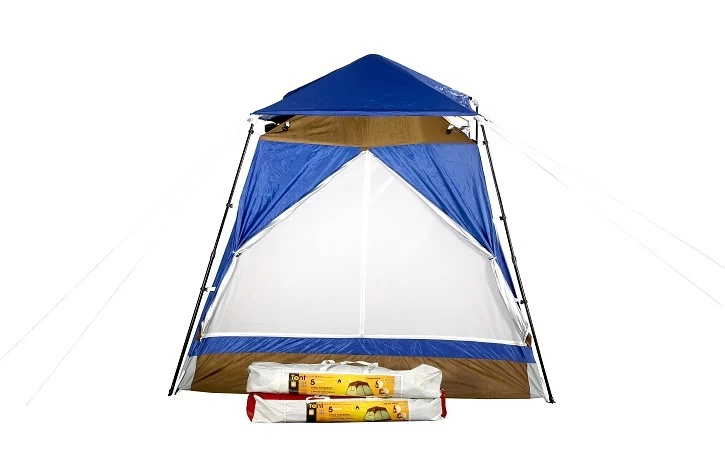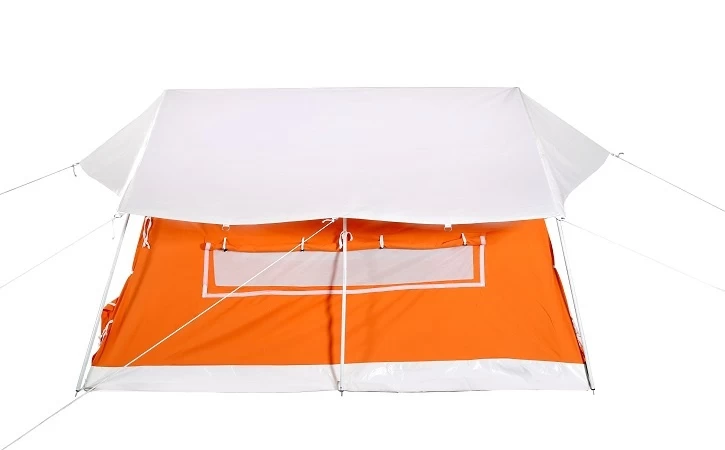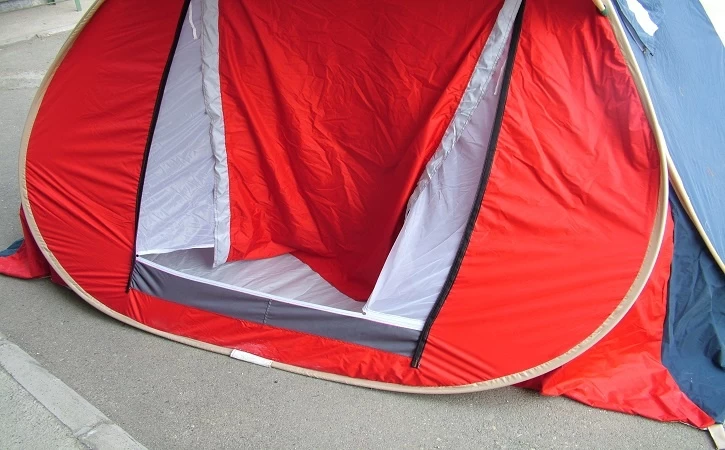Tent
Tents are portable shelters commonly used for camping or outdoor activities. They come in various sizes and designs, from simple dome tents to spacious family tents. Most tents consist of a waterproof outer layer and a breathable inner layer, providing protection from the elements while allowing airflow. Setup usually involves assembling poles and securing the tent with stakes. Tents play a crucial role in outdoor adventures, offering a temporary home in nature.
To set up a tent, follow these general steps:
1. Select a Campsite:Choose a flat and dry area, away from hazards like rocks or roots. Ensure it complies with any camping regulations.
2. Lay out the Tent:Unfold the tent and lay it flat on the ground. Position it so that doors and windows face the desired direction.
3. Assemble Poles:If your tent has poles, assemble them according to the instructions. Slide them through the designated sleeves or attach them using clips.
4. Raise the Tent: Lift the tent by pulling on the poles until it stands upright. If it's a pop-up tent, it might unfold automatically.
5. Stake the Tent: Secure the tent to the ground using stakes at each corner. For added stability, attach guylines to loops on the tent and stake them out.
6. Attach Rainfly:If your tent has a rainfly (waterproof cover), position it over the tent and secure it using hooks or straps.

When dismantling, reverse the steps. Clean and dry your tent before packing it away to prevent mold. Familiarize yourself with your specific tent's instructions for the best setup.
tents are typically made from various fabrics to provide protection against the elements. The outer layer, or rainfly, is often constructed from waterproof materials like polyester or nylon to repel rain. The inner layer, known as the tent body, is usually made from breathable fabrics to allow airflow. The flooring is commonly a durable, waterproof material such as polyethylene or coated nylon to keep moisture from seeping in from the ground.
Tent poles are typically made from lightweight materials like aluminum or fiberglass, providing structure and support to the fabric. The combination of these materials ensures that tents are portable, weather-resistant, and suitable for various outdoor conditions.
Tents come in various shapes and types, each designed for specific purposes. Here are some common types:
1. Dome Tents: Rounded or dome-shaped with a simple structure. They are easy to set up and provide good stability.
2. A-Frame Tents: Resemble the letter "A" and are known for their simplicity. They are often compact and suitable for backpacking.
3. Tunnel Tents:Long, tube-like structures that provide ample interior space. They are often used for larger group camping.
4. Cabin Tents: Rectangular and spacious with vertical walls, resembling a cabin. They are suitable for family camping and often have multiple rooms.
5. Pop-Up Tents: Quick and easy to set up, with a collapsible frame that pops into shape. Popular for quick camping trips.
6. Geodesic Tents: Dome-shaped but with additional poles crisscrossing for extra stability. Ideal for harsh weather conditions.
7. Rooftop Tents: Designed to be mounted on vehicles, providing an elevated sleeping platform for camping on top of a car or truck.
These are just a few examples, and there are numerous variations within each category to suit different preferences and needs.
Tents are neither furniture nor home appliances. Tents fall into the category of outdoor gear or camping equipment. They are portable shelters used primarily for outdoor activities like camping, hiking, or festivals. While they provide a temporary living space, they are not considered furniture or appliances typically associated with indoor settings. Tents serve the purpose of providing shelter in various outdoor environments.
tents are indeed outdoor equipment. They are designed for use in outdoor environments and are commonly used in various settings, including:
1. Camping:Tents are a fundamental part of camping gear, providing a portable shelter for sleeping and protection from the elements.
2. Hiking and Backpacking: Lightweight and compact tents are popular among hikers and backpackers who need a shelter for overnight stays during their outdoor adventures.
3. Festivals:Tents are often used at music festivals and other outdoor events to provide temporary accommodation for attendees.
4. Backyard Camping:Some people set up tents in their own backyard for a fun and convenient camping experience close to home.
5. Mountaineering: Specialized tents designed for extreme conditions are used by mountaineers on high-altitude expeditions.
6. Beach Camping:Tents can be used for camping near the beach, offering shade and shelter from wind.
7. Car Camping: Campers who drive to their camping spot often use tents as part of their car camping setup.

In essence, tents are versatile outdoor shelters that find application in a variety of recreational and practical scenarios.
Tents are typically not made entirely of plastic, but they may incorporate synthetic materials, including plastics, for various components. The primary materials used in tent construction are:
1. Polyester:A synthetic fabric commonly used for tent rainflies and inner tent walls. It is durable, lightweight, and provides good water resistance.
2. Nylon: Another synthetic fabric used for tent construction. It is lightweight, strong, and often used in the rainfly, tent body, or flooring.
3. Polyethylene: A plastic material commonly used for tent floors due to its waterproof and durable nature.
While tents incorporate these synthetic materials, they also include metal components (like aluminum or fiberglass poles) and various other materials to ensure a balance of strength, durability, and weather resistance.
The best size for a tent depends on your specific needs and the number of people using it. Here are some general guidelines:
1. Solo Camping: A one-person tent is compact and lightweight, ideal for solo backpacking trips.
2. Couples Camping: A two-person tent provides enough space for two adults and their gear. Consider a slightly larger tent for extra comfort.
3. Family Camping:For families, choose a tent with a capacity that accommodates everyone. Consider a larger tent with multiple rooms for added privacy.
4. Group Camping: If camping with a group, look for larger tents designed to accommodate the number of people in your party.
Remember that the "capacity" specified by the tent manufacturer is often a snug fit, so if you prefer more space, consider sizing up. Additionally, features like vestibules for gear storage and headroom are essential factors to consider for comfort.
Tents come in various sizes, and their dimensions are typically specified by the manufacturer. Here are some general size categories:
1. One-Person Tents:These tents are designed for solo campers and usually have a floor area of around 15 to 30 square feet.
2. Two-Person Tents: Suitable for couples or solo campers who prefer extra space. They typically have a floor area ranging from 30 to 40 square feet.
3. Family Tents: Family tents can range from 4-person tents with around 60 square feet of floor space to much larger tents for larger families, providing 100 square feet or more.
It's essential to consider not only the tent's size but also its peak height, as this can affect comfort, especially when standing or moving around inside. Always check the manufacturer's specifications for accurate size information.
To set up a tent, follow these general steps:

tents are typically made from various fabrics to provide protection against the elements. The outer layer, or rainfly, is often constructed from waterproof materials like polyester or nylon to repel rain. The inner layer, known as the tent body, is usually made from breathable fabrics to allow airflow. The flooring is commonly a durable, waterproof material such as polyethylene or coated nylon to keep moisture from seeping in from the ground.
Tents are neither furniture nor home appliances. Tents fall into the category of outdoor gear or camping equipment. They are portable shelters used primarily for outdoor activities like camping, hiking, or festivals. While they provide a temporary living space, they are not considered furniture or appliances typically associated with indoor settings. Tents serve the purpose of providing shelter in various outdoor environments.
tents are indeed outdoor equipment. They are designed for use in outdoor environments and are commonly used in various settings, including:

Tents are typically not made entirely of plastic, but they may incorporate synthetic materials, including plastics, for various components. The primary materials used in tent construction are:
The best size for a tent depends on your specific needs and the number of people using it. Here are some general guidelines:
Tents come in various sizes, and their dimensions are typically specified by the manufacturer. Here are some general size categories:
FAQs
Is a tent waterproof?
Tents are water-resistant, but not entirely waterproof.
What is the best material for a tent?
Polyester and nylon are popular for tent construction.
Are tents made for rain?
Yes, tents are designed to provide shelter during rain.
Which tent is best for camping?
The best tent depends on your camping needs. Consider size, weight, and weather resistance.
 +7929688-88-14
+7929688-88-14

 English
English
 Persian
Persian
 Russian
Russian
 Chinese
Chinese


 +7929688-88-14
+7929688-88-14





